#last posting dates
Text



Royal Mail Latest Posting Dates from @royalmailofficial
#etsy#etsy shop#witch#etsy seller#witchcraft#small business#witches#etsy store#mori moon co#support small businesses#royal mail#last posting dates
6 notes
·
View notes
Text
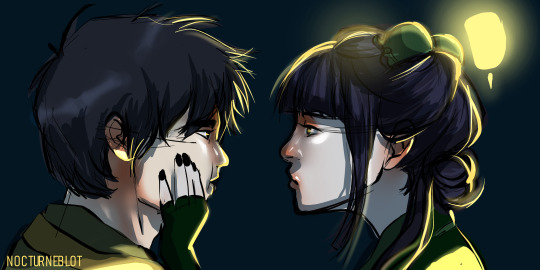

"Not everything's changed" -Mai, Going Home Again
#there's so many things i wanna draw and draw well from going home again#drew this for stress relief because other work refused to get done#but ended up getting more stressed because it wouldn't turn out how i wanted#or maybe it's cause i was lazy and didn't want to put in the effort#why is life like this#maiko#atla mai#mai#zuko#going home again comic#going home again#atla comics#atla#avatar the last airbender#artists on tumblr#fanart#ink blot#this is also the last piece im posting without glaze or nightshade on it#the last one i swear#might redraw it sometime in the future#used carbon dating on this one
604 notes
·
View notes
Text
*After Diavolo went on a date with Mc, Mc decided to stay there for some days*
Mammon: have any of you seen Mc?
Satan: since yesterday? No, I don't think so.
Mammon: great...
Mammon: I really need their opinion on something, but oh well.
Satan: is it something stupid?
Mammon: ...maybe?
Satan: *sigh* then go ahead and do it, you know Mc would aprove anything you do
Mammon: ^-^
Mc: I feel like my name is being used for something stupid
Barbatos: as in? *is on a tea date with Mc*
Mc: I don't know, but I get this tingly feeling whenever the brothers use my name for something stupid...
Barbatos: Oh, well then, let's hope for the better. Would you like some more tea?
Mc: yes please! I can't say no to that!
Mammon: *is in the human realm buying a summer house for him and Mc*
Mammon: HEHEHEHE Lucifer is gonna be so mad and jelly~
Salesman: it will be... 3 million. Cash or card?
Mammon: Card please *hands him Lucifers card*
Salesman: alright.. done. I hope you enjoy your new summer house sir.
Mammon: it's for my beloved
Salesman: oh. Valentines day, huh?
Mammon: as an apologie.
Salesman: you forgot valentines day, huh?
Mammon: ...yeah kind of...
#obey me#obey me shall we date#obey me nightbringer#obey me mammon#obey me barbatos#obey me satan#om! satan#om! mammon#om! barbatos#aftermath of my last post#question should I post barbs x mc?#or not?#idk you guys choose#i like barbs x mc so I am fine with it
533 notes
·
View notes
Text
Feel free to share which is your favorite NOW in the tags, but this particular poll is about which you preferred as a child! ⭐ These are being grouped by a vague theme, so in a few days we'll do another one with more options!
Also, same rule as the last poll: REALLY popular choices (ATLA, SpongeBob, Scooby Doo, Pokemon, Digimon, etc.) are overwhelmingly popular and have been omitted for the sake of seeing the results for other shows!
Also also, one of these polls is going to be like "baby's first anime" so more specific anime choices will be on that poll, don't worry ✨
#polls#The last poll kept getting comments like ''YOU FORGOT/IGNORED ____''#like. it's right there on the post that we're doing several of these polls and a poll can only have so many choices😭#also it's for my own curiosity about shows i watched as a kid so obviously not every show known to humankind is going to be on here#''this poll is all CN/Nick where is PBS and Disney!!!''#COMING SOON IT'S RIGHT THERE IN THE CAPTION 😭😭#AND ANOTHER THING so many of the ''where is ____!'' comments were out of the timeframe of the poll#Like. The Amazing World of Gumball. pls. pls look at the other choices and consider these dates
445 notes
·
View notes
Text
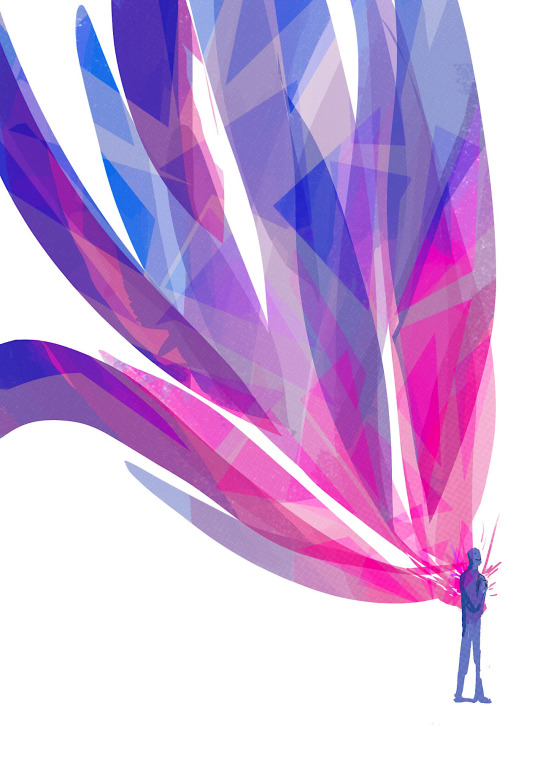
yeah
#me accepting my bisexuality years ago (colorized)#lgbt#artists on tumblr#illustration#art#sketch#lgbtq#bisexual#woo color tags. i meant to do this for the last day of pride month but did not look at the date lol#sometimes posts will just not show up on this webbed site. love that
1K notes
·
View notes
Text

Redraw of my first post on this blog. Oh how far we've come B'*)
#better drawn mdzs#mdzs#wei wuxian#lan wangji#Credit where it's due: the first one is from November 2022. So its been a bit longer than the post date implies.#It was always part of the plan to re-draw my first wangxian art at the end of each season#but wow I really didn't give enough credit to the power of drawing every day for the last half a year#I've really loved doing this B*) I have found so much confidence in accepting the fact I'm not a 'non-artist' drawing mdzs comics#I'm a REAL artist drawing mdzs#and this is just the start!!!! I will keep drawing and improving and learning! and I will have a big smile like this every time -> B*)#I'm stunned that so many people found this blog so early on. Despite the roughness of my art...yall saw what I struggled to see#which was someone who was worth it#That and how art really is what you decide it is. I thought It had to be perfect. It doesn't need to be perfect. I see that now#I love you all so much! I am so much happier than I have been in years!#Sorry for being sappy twice in a row I promise tomorrow I'll be your little jester again
1K notes
·
View notes
Text

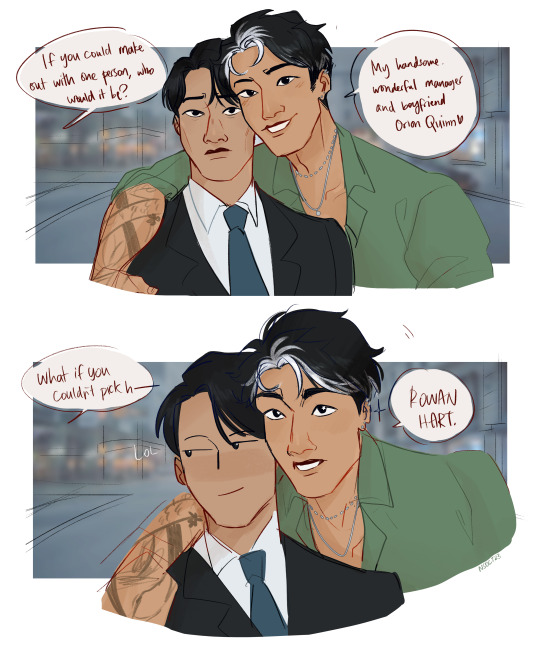


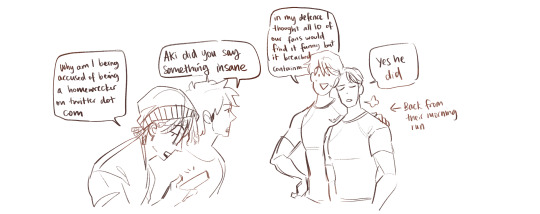
the established orion-romance dreams have gotten to me. what will my delusional visions reveal to me next <3
#not even sure if this is in character. but i enjoy the idea of orion making aki want to be better :)#infamous if#infamous#akihiro yasumi#orion quinn#my art#the mile long thinkpiece i sent to flor yesterday about their relationship. i think perhaps the next infamous update may break me#long post#i literally . think about that ask. about how he loosens up during the course of his romance. aughghghghahhwAUUAUGHGHGHHH#ALSO re the last comic. 'average lead singer proposes to their bandmates 10000 times per year' statistical error#aki who is really annoying and will get down on one knee for literally any of his band for any reason#is an outlier and should not have been counted.#its funny until the dating rumours about ur band get extremely convoluted
608 notes
·
View notes
Text
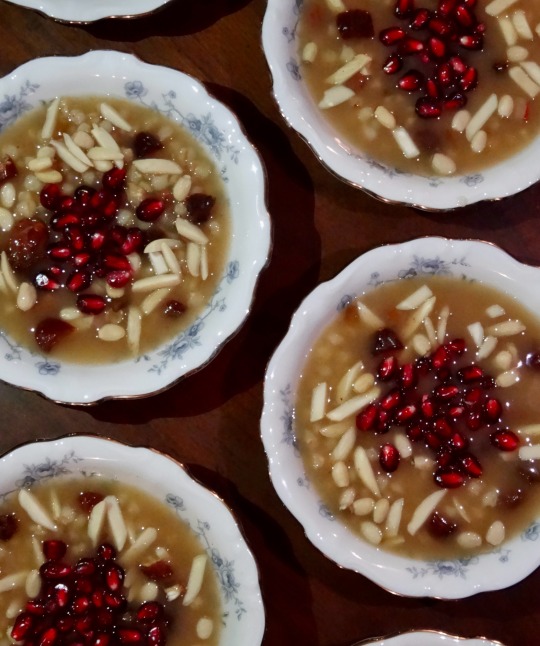
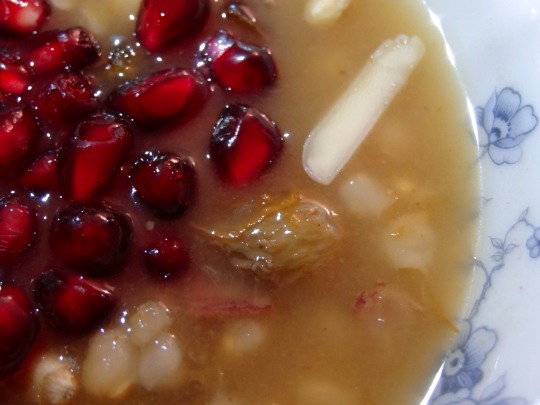
[ID: First image shows four small porcelain bowls of a pudding topped with slivered almonds and pomegranates seeds, seen from above. Second image is an extreme close-up showing the blue floral pattern on the china, slivered almonds, golden raisins, and pomegranate seeds on top of part of the pudding. End ID]
անուշապուր / Anush apur (Armenian wheat dessert)
Anush apur is a sweet boiled wheat pudding, enriched with nuts and dried fruits, that is eaten by Armenians to celebrate special occasions. One legend associates the dish with Noah's Ark: standing on Mt. Ararat (Արարատ լեռը) and seeing the rainbow of God's covenant with humanity, Noah wished to celebrate, and called for a stew to be prepared; because the Ark's stores were diminishing, the stew had to be made with small amounts of many different ingredients.
The consumption of boiled grains is of ancient origin throughout the Levant and elsewhere in West Asia, and so variations of this dish are widespread. The Armenian term is from "անուշ" ("anush") "sweet" + "ապուր" ("apur") "soup," but closely related dishes (or, arguably, versions of the same dish) have many different, overlapping names.
In Arabic, an enriched wheat pudding may be known as "سْنَينِيّة" ("snaynīyya"), presumably from "سِنّ" "sinn" "tooth" and related to the tradition of serving it on the occasion of an infant's teething; "قَمْح مَسْلُوق" ("qamḥ masluq"), "boiled wheat"; or "سَلِيقَة" ("salīqa") or "سَلِيقَة القَمْح" ("salīqa al-qamḥ"), "stew" or "wheat stew," from "سَلَقَ" "salaqa" "to boil." Though these dishes are often related to celebrations and happy occasions, in some places they retain an ancient association with death and funerary rites: qamh masluq is often served at funerals in the Christian town of بَيْت جَالَا ("bayt jālā," Beit Jala, near Bethlehem).
A Lebanese iteration, often made with milk rather than water, is known as "قَمْحِيَّة" ("qamḥīyya," from "qamḥ" "wheat" + "ـِيَّة" "iyya," noun suffix).
A similar dish is known as "بُرْبَارَة" ("burbāra") by Palestinian and Jordanian Christians when eaten to celebrate the feast of Saint Barbara, which falls on the 4th of December (compare Greek "βαρβάρα" "varvára"). It may be garnished with sugar-coated chickpeas and small, brightly colored fennel candies in addition to the expected dried fruits and nuts.
In Turkish it is "aşure," from the Arabic "عَاشُوْرَاء" ("'āshūrā"), itself from "عَاشِر" ("'āshir") "tenth"—because it is often served on the tenth day of the month of ٱلْمُحَرَّم ("muḥarram"), to commemorate Gabriel's teaching Adam and Eve how to farm wheat; Noah's disembarkment from the Ark; Moses' parting of the Red Sea; and the killing of the prophet الْحُسَيْن بْنِ عَلِي (Husayn ibn 'Ali), all of which took place on this day in the Islamic calendar. Here it also includes various types of beans and chickpeas. There is also "diş buğdayı," "tooth wheat" (compare "snayniyya").
These dishes, as well as slight variations in add-ins, have varying consistencies. At one extreme, koliva (Greek: "κόλλυβα"; Serbian: "Кољиво"; Bulgarian: "Кутя"; Romanian: "colivă"; Georgian: "კოლიო") is made from wheat that has been boiled and then strained to remove the boiling water; at the other, Armenian anush apur is usually made thin, and cools to a jelly-like consistency.
Anush apur is eaten to celebrate occasions including New Year's Eve, Easter, and Christmas. In Palestine, Christmas is celebrated by members of the Armenian Apostolic church from the evening of December 24th to the day of December 25th by the old Julian calendar (January 6th–7th, according to the new Gregorian calendar); Armenian Catholics celebrate on December 24th and 25th by the Gregorian calendar. Families will make large batches of anush apur and exchange bowls with their neighbors and friends.
The history of Armenians in Palestine is deeply interwoven with the history of Palestinian Christianity. Armenian Christian pilgrimages to holy sites in Palestine date back to the 4th century A.D., and permanent Armenian monastic communities have existed in Jerusalem since the 6th century. This enduring presence, bolstered by subsequent waves of immigration which have increased and changed the character of the Armenian population in Palestine in the intervening centuries, has produced a rich history of mutual influence between Armenian and Palestinian food cultures.
In the centuries following the establishment of the monasteries, communities of Armenian laypeople arose and grew, centered around Jerusalem's Վանք Հայոց Սրբոց Յակոբեանց ("vank hayots surbots yakobeants"; Monastery of St. James) (Arabic: دَيْر مَار يَعْقُوب "dayr mār ya'qūb"). Some of these laypeople were descended from the earlier pilgrims. By the end of the 11th century, what is now called the Armenian Quarter—an area covering about a sixth of the Old City of Jerusalem, to the southwest—had largely attained its present boundaries.
Throughout the 16th and 17th centuries, the Patriarchate in Jerusalem came to have direct administrative authority over Armenian Christians across Palestine, Lebanon, Egypt, and Cyprus, and was an important figure in Christian leadership and management of holy sites in Jerusalem (alongside the Greek Orthodox and Roman Catholic churches). By the middle of the 19th century, a small population of Armenian Catholics had joined the larger Armenian Apostolic community as permanent residents in Jerusalem, living throughout the Muslim Quarter (but mostly in a concentrated enclave in the southwest); in the beginning of the 20th century, there were between 2,000 and 3,000 Armenians of both churches in Palestine, a plurality of whom (1,200) lived in Jerusalem.
The Turkish genocide of Armenians beginning in 1915 caused significant increases in the populations of Armenian enclaves in Palestine. The Armenian population in Jerusalem grew from 1,500 to 5,000 between the years of 1918 and 1922; over the next 3 years, the total number of Armenians in Palestine (according to Patriarchate data) would grow to 15,000. More than 800 children were taken into Armenian orphanages in Jerusalem; students from the destroyed Չարխափան Սուրբ Աստվածածին վանք (Charkhapan Surb Astvatsatsin Monastery) and theological seminary in Armash, Armenia were brought to the Jerusalem Seminary. The population of Armenian Catholics in the Muslim Quarter also increased during the first half of the 20th century as immigrants from Cilicia and elsewhere arrived.
The immediate importance of feeding and housing the refugees despite a new lack of donations from Armenian pilgrims, who had stopped coming during WW1—as well as the fact that the established Armenian-Palestinians were now outnumbered by recent immigrants who largely did not share their reformist views—disrupted efforts on the part of lay communities and some priests to give Armenian laypeople a say in church governance.
The British Mandate, under which Britain assumed political and military control of Palestine from 1923–1948, would further decrease the Armenian lay community's voice in Jerusalem (removing, for example, their say in elections of new church Patriarchs). The British knew that the indigenous population would be easier to control if they were politically and socially divided into their separate religious groups and subjected to the authority of their various religious hierarchies, rather than having direct political representation in government; they also took advantage of the fact that the ecclesiastical orders of several Palestinian Christian sects (including the Armenian Patriarchate of Jerusalem) comprised people from outside of Palestine, who identified with religious hierarchy and the British authorities more than they identified with the Palestinian lay communities.
British policy, as well as alienating Armenians from politics affecting their communities, isolated them from Arab Palestinians. Though the previously extant Armenian community (called "քաղաքացի" "kaghakatsi," "city-dwellers") were thoroughly integrated with the Arab Palestinians in the 1920s, speaking Arabic and Arabic-accented Armenian and eating Palestinian foods, the newer arrivals (called "زُوَّار" / "զուվվար" "zuwwar," "visitors") were unfamiliar with Palestinian cuisine and customs, and spoke only Armenian and/or Turkish. Thus British policies, which differentiated people based on status as "Arab" (Muslim and Christian) versus "Jewish," left new Armenian immigrants, who did not identify as Arab, disconnected from the issues that concerned most Palestinians. They were predominantly interested in preserving Armenian culture, and more concerned with the politics of the Armenian diaspora than with local ones.
Despite these challenges, the Armenian Patriarchate of Jerusalem came to be a vital center of religious and secular culture for the Armenian diaspora during the British Mandate years. In 1929, Patriarch Yeghishe Turian reëstablished the Սուրբ Յակոբեանց Տպարան ("surbots yakobeants taparan"; St. James printing house); the Patriarchate housed important archives relating to the history of the Armenian people; pilgrimages of Armenians from Syria, Lebanon, and Egypt increased and the economy improved, attracting Armenian immigrants in higher numbers; Armenians held secular roles in governance, policing, and business, and founded social, religious, and educational organizations and institutions; Armenians in the Old and New Cities of Jerusalem were able to send financial aid to Armenian victims of a 1933 earthquake in Beirut, and to Armenians expelled in 1939 when Turkey annexed Alexandretta.
The situation would decline rapidly after the 1947 UN partition resolution gave Zionists tacit permission to expel Palestinians from broad swathes of Palestine. Jerusalem, intended by the plan to be a "corpus separatum" under international administration, was in fact subjected to a months-long war that ended with its being divided into western (Israeli) and eastern (Palestinian) sections. The Armenian population of Palestine began to decline; already, 1947 saw 1,500 Armenians resettled in Soviet Armenia. The Armenian populations in Yafa and Haifa would fall yet more significantly.
Still, the Armenian Patriarchate of Jerusalem maintained its role as the center of Armenian life in Palestine; the compound provided food and shelter to thousands of Armenians during the Battle for Jerusalem and the Nakba (which began in 1948). Some Armenians formed a militia to defend the Armenian Quarter against Haganah shelling during the battle.
In the following years, historical British contributions to the shoring up of insular power in the Patriarchate would cause new problems. The Armenian secular community, no longer empowered to oversee the internal workings of the Patriarchate, could do nothing to prevent embezzling, corruption, and even the sale of church-owned land and buildings to settlers.
In 1967, Israeli military forces annexed East Jerusalem, causing another, albeit smaller, surge in Armenian emigration from the city. Daphne Tsimhoni estimates based on various censuses that the Armenian population of Jerusalem, which had reached 5,000-7,000 at its peak in 1945–6, had fallen back to 1,200 by 1978.
Today, as in the 20th century, Armenians in Jerusalem (who made up nearly 90% of the Armenian population of Palestine as of 1972) are known for the insularity of their community, and for their skill at various crafts. Armenian food culture has been kept alive and well-defined by successive waves of immigrants. As of 2017, the Armenian Patriarchate supplied about 120 people a day with Armenian dishes, including Ղափամա / غاباما "ghapama" (pumpkin stuffed with rice and dried fruits), թոփիկ / توبيك "topig" (chickpea-and-potato dough stuffed with an onion, nut, fruit, and herb filling, often eaten during Lent), and Իչ / ايتش "eetch" (bulgur salad with tomatoes and herbs).
Restaurants lining the streets of the Armenian and Christian quarters serve a mixture of Armenian and Palestinian food. Լահմաջո "lahmadjoun" (meat-topped flatbread), and հարիսա / هريس "harisa" (stew with wheat and lamb) are served alongside ֆալաֆել / فلافل ("falafel") and մուսախան / مسخن ("musakhkhan"). One such restaurant, Taboon Wine Bar, was the site of a settler attack on Armenian diners in January 2023.
Up until 2023, despite fluctuations in population, the Armenian community in Jerusalem had been relatively stable when compared to other Armenian communities and to other quarters of the Old City; the Armenian Quarter had not been subjected to the development projects to which other quarters had been subjected. However, a deal which the Armenian Patriarchate had secretly and unilaterally made with Israel real estate developer Danny Rotham in 2021 to lease land and buildings (including family homes) in the Quarter led Jordan and Palestine to suspend their recognition of the Patriarch in May of 2023.
On 26th October, the Patriarchate announced that it was cancelling the leasing deal. Later the same day, Israeli bulldozers tore up pavement and part of a wall in حديقة البقر ("ḥadīqa al-baqar"; Cows' Garden; Armenian: "Կովերի այգու"), the planned site of a new luxury hotel. On 5th November, Rothman and other representatives of Xana Gardens arrived with 15 settlers—some of them with guns and attack dogs—and told local Armenians to leave. About 200 Armenian Palestinians arrived and forced the settlers to stand down.
On 12th and 13th November, the developer again arrived with bulldozers and attempted to continue demolition. In response, Armenian Palestinians have executed constant sit-ins, faced off against bulldozers, and set up barricades to prevent further destruction. The Israeli occupation police backed settlers on another incursion on 15th November, ordering Armenian residents to vacate the land and arresting three.
On December 28th, a group of Armenian bishops, priests, deacons, and seminary students (including Bishop Koryoun Baghdasaryan, the director of the Patriarchate's real estate department) were attacked by a group of more than 30 people armed with sticks and tear gas. The Patriarchate attributed this attack to Israeli real estate interests trying to intimidate the Patriarchate into abandoning their attempt to reverse the lease through the court system. Meanwhile, anti-Armenian hate crimes (including spitting on priests) had noticeably increased for the year of 2023.
These events in Palestine come immediately after the ethnic cleansing of Լեռնային Ղարաբաղ ("Lernayin Gharabagh"; Nagorno-Karabakh); Israel supplied exploding drones, long-range missiles, and rocket launchers to help Azerbaijan force nearly 120,000 Armenians out of the historically Armenian territory in September of 2023 (Azerbaijan receives about 70% of its weapons from Israel, and supplies about 40% of Israel's oil).
Support Palestinian resistance by donating to Palestine Action’s bail fund; buying an e-sim for distribution in Gaza; or donating to help a family leave Gaza.
Ingredients
180g (1 cup) pearled wheat (قمح مقشور / խոշոր ձաւար), soaked overnight
3 cups water
180-360g (a scant cup - 1 3/4 cup) sugar, or to taste
Honey or agave nectar (optional)
1 cup total diced dried apricots, prunes, golden raisins, dried figs
1 cup total chopped walnuts, almonds, pistachios
1 tsp rosewater (optional)
Ceylon cinnamon (դարչին) or cassia cinnamon (կասիա)
Aniseed (անիսոն) (optional)
Large pinch of salt
Pomegranate seeds, to top (optional)
A Palestinian version of this dish may add pine nuts and ground fennel.
Pearled wheat is whole wheat berry that has gone through a "pearling" process to remove the bran. It can be found sold as "pearled wheat" or "haleem wheat" in a halal grocery store, or a store specializing in South Asian produce.
Amounts of sugar called for in Armenian recipes range from none (honey is stirred into the dish after cooking) to twice the amount of wheat by weight. If you want to add less sugar than is called for here, cook down to a thicker consistency than called for (as the sugar will not be able to thicken the pudding as much).
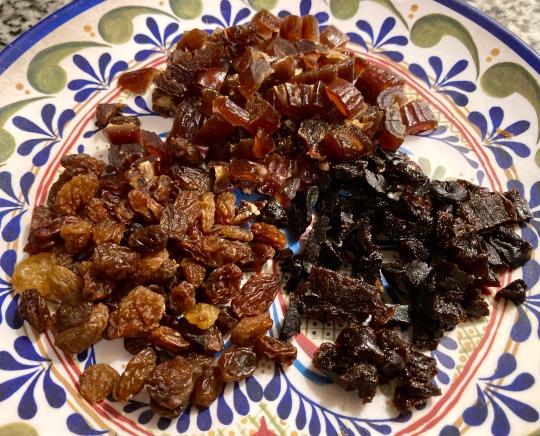
Instructions
1. Submerge wheat in water and scrub between your hands to clean and remove excess starch. Drain and cover by a couple inches with hot water. Cover and leave overnight.
2. Drain wheat and add to a large pot. Add water to cover and simmer for about 30 minutes until softened, stirring and adding more hot water as necessary.

Wheat before cooking
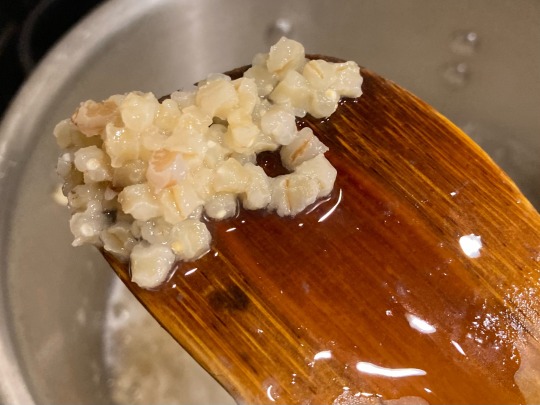
Wheat after cooking
3. Add dried fruit, sugar, salt, and spices and simmer for another 30 minutes, stirring occasionally, until wheat is very tender. Add water as necessary; the pudding should be relatively thin, but still able to coat the back of a spoon.
4. Remove from heat and stir in rosewater and honey. Ladle pudding into individual serving bowls and let cool in the refrigerator. Serve cold decorated with nuts and pomegranate seeds.
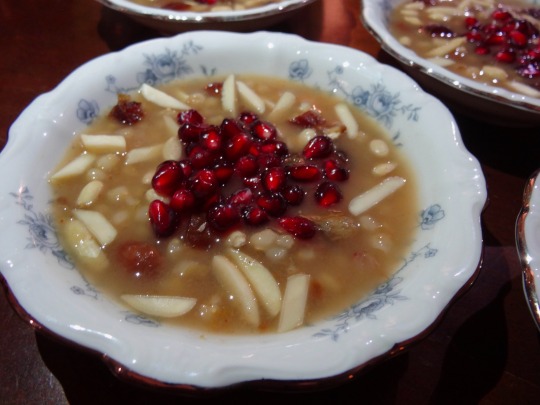
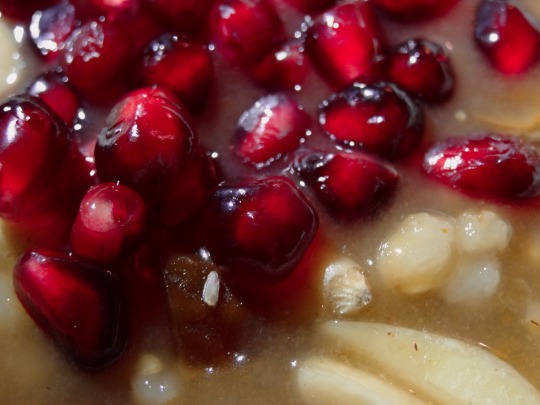
#the last link is a different / new fundraiser#Armenian#Palestinian#fusion#wheat berries#pearled wheats#pomegranate#prunes#dried apricot#dates#long post /
364 notes
·
View notes
Text
Toph Beifong doesn’t hold up as disability representation - Disability in the Media

[ID: A screenshot of Toph, a twelve-year-old girl with black hair in a loose, green and tan short-sleeve shirt and shorts, cheering in an arena. Next to text written in a rough, blocky font: "Disability in Media - Toph Beifong Doesn't hold up as disability representation" /End ID]
Avatar the Last Airbender is one of my all-time favourite TV-shows, and Toph is still easily one of my favourite members of Team Avatar. I was a few years younger than Toph when the show first started airing, and being a disabled kid who was into martial arts, constantly being dismissed by my able-bodied opponents and teachers, meant that I connected very strongly with her right from the get-go.
But upon my last couple of rewatches of the series, I began to come to the realisation that my opinions on Toph as a shining example of good disability representation were... well, pretty heavily influenced by my nostalgia for the show and that many aspects of Toph's character just don't hold up today. Which, honestly is fair, the show is nearly 19 years old (if it were a person in my country, it would be old enough to drink) and I think it's pretty ridiculous to expect every part of every character from an 19 year old show to age well. So today I wanted to talk about the things I think Avatar the original Last Airbender did right with Toph, where I think they missed the mark, and what changes I think would need to be made to Toph to make her work for a modern audience.
So let's start with why I think Toph doesn't really hold up as "good disability representation" today, and the elements of her character that just haven't aged as well.
For me, one of the biggest issues I noticed upon rewatching the show, is how often we are told (often by Toph herself) that she is blind, but how infrequently we are actually shown it's impact on her life beyond her bending or outside of jokey contexts. Outside of her bending, we only ever see her blindness impacting her ability to do things like read or write, otherwise, she functionally has full vision -so far as the audience is informed - with the only exceptions being when she's in the air or water (e.g. on Appa or in the submarines) or in loose soil (e.g. the desert). Having places and circumstances where she doesn't have access to her power that allows her to "see" was a step in the right direction, but I do think it would have been better if her seismic sense wasn't quite as accurate, even in the most ideal of circumstances.
But why? Well, I think Suki explains it really well, long before Toph is even introduced. when Sokka says "I should have seen you as a warrior instead of a girl" Suki stops him and says "I am a warrior, but I'm also a girl". Being a warrior and a woman are both important parts of Suki's character, and only recognising her as one or the other means ignoring a big part of who she is, and the same is true for Toph. Being blind is a big part of toph's character that has informed a lot of her life, but so is being a warrior and bending master. Many people see Toph as a warrior or fighter, but ignore her disability, but both are important. She's disabled, and a warrior, and those things don't cancel each other out, the same way being a warrior doesn't diminish Suki's status as a woman.
When the show was still airing though (and even still today) it was very common to see non-disabled fans of the show exclaiming that they honestly forget that Toph is even blind sometimes, with many people going so far as to say that she's not even disabled (and that this was a good thing). While I do think some of that comes from the fact they weren't used to seeing a disabled character as both disabled and an active participant in these kinds of stories, I do think this mostly happened because of the show's lack of, well, showing the impact of her blindness on her daily life and allowing her earthbending and seismic sense to erase the effects of her disability to some extent. It's much harder to forget a character is blind when it impacts their daily life in ways that are shown to the audience. This doesn't have to be in big, showy ways mind you, showing things subtly but consistently works way better than one "very special episode" type setup.
In the show as it is though, the seismic sense functionally gives Toph a perfect image of her surroundings until it's just not available anymore for *plot reasons*.

[ID: A black and white shot of Toph and how she sees the oponent she's fighting, with shockwaves radiating from him towards her to indicate how she's interpreting the scene. Her foe has jumped into the air and now has his hand dug into the ground of an arena, about to launch rocks towards her. /End ID]
In many ways, her picture of the world is better and clearer than what the non-disabled characters can see, leading to this feeling of her disability being erased. It may have been better though if the seismic sense could give her a general idea of big things in her immediate vicinity but she still missed the finer details, functioning at least a little bit more like a tactile/earthy-vibration version of the limited sight some legally-blind people have in real life. Things like a person's position, movement and overall pose would still be "visible" to her in a general sense, as well as big things in the environment (including things underground, since there are a few plot-points that require that), but smaller things like details about objects and creatures, people's facial expressions or what they're doing with parts of their body that have no direct contact with the ground (like their hands) is less clear.
On top of this, she may struggle to detect smaller, lighter objects or creatures that realistically wouldn't cause much of a vibration at all. creatures as small and as light as Momo and Hawky for example might be detectable, but "fuzzy" to her, and anything smaller might make enough of a vibration to tell her it's there when it moves, but not enough for her to be able to tell what specifically it is without some other cue (such as sound). There are a few moments in the show that seem to imply this is what they were initially going for, but it's not really consistent, and is directly contradicted in her debut episode, "the blind bandit" when she explains that she can even "see" something as small as the ants off in the distance.
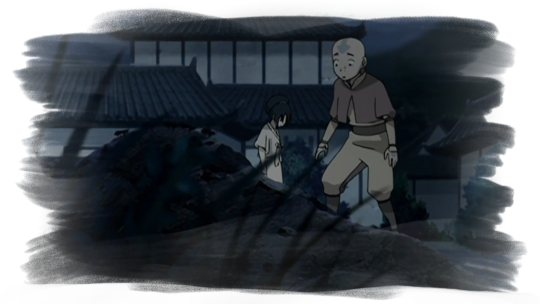
[ID: A shot of Aang, a twelve-year-old bald boy with an arrow tattoo on his head, dressed in a yellow and orange outfit, standing with Toph at night. In the foreground is an anthill will a trail of ants, which Aang is looking for. /End ID]
With an adjustment like what I'm suggesting though, she still serves her narrative purpose of teaching Aang the importance of being able to wait and listen - possibly even more so, as her needing to wait and collect more information in order to get a clearer image before striking, would back-up what Bumi tells Aang that he needs in an earth bending master. It would also still help to illustrate the connectedness of the world, a theme Toph continues to embody heavily in The Legend of Korra, while still showing the ways her disability impacts her more frequently.
When I talked about the "super-crip" trope a while back, I mentioned that one way to avoid the more harmful elements of the trope (where the character's disability is erased by their powers) is to use the ability in question more like a mobility or disability aid than a straight-up cure. The power should help them, but shouldn't make their disability redundant. People are creative and we would find ways to use a superpower or magic to help with our disabilities if it were available in real life, but what's the point of including a disabled character if you're just going to functionally erase their disability? For a character like Toph, I think this is the kind of approach that should be taken with her. Her seismic sense still helps her, but it's not a perfect replacement. (Ironically, I did use Toph as a "good" example of that trope, but I do think after this last rewatch, for the reasons I'm discussing here, I might have to backtrack that a bit).
I considered giving an alternative approach here, to keep the sensitivity of toph's seismic sense as it is in the show as is, but giving it draw-backs such as making her susceptible to sensory overload similar to what autistic people experience. However, while replacing one disability with another can work for some characters and stories, I don't think it's the best adjustment to make for Toph or any blind character, largely thanks to this also being a trope. The "blind (or d/Deaf) person who's other senses become super-human to make up for it" trope is very common in fantasy, sci-fi as well as older martial arts films, and while I'm not really the best person to cover it, I do know that members of both the blind and deaf communities have expressed a lot of frustration with it. Toph already falls into this trope quite a bit, and any suggestions I could make would have just dialled that element up to 11, and fixing one problem with another is never a good idea.
Another thing that actually did bug me for a while, even before my most recent rewatch of the show, is how Toph is treated on the rare occasions she does point out something won't working for her. There are a number of times where Toph advocates for herself and points out that something The Gaang is doing isn't accessible to her or sets a boundary to do with her disability, and she's either left behind, her concerns are brushed off or she's ignored entirely. The three most noticeable examples of this are in the Episodes "The Ember Island Players," "The Library," and Toph and Katara's segment of "Tales of Ba Sing Se."
In the Ember Island Players, Toph complains that the seats they have for the play are too high up and too far away, and she's unable to "see" what's happening on stage. Her friends don't really take any notice of her though except for Katara who tells her not to worry, "I'll tell your feet what's happening."

[ID: A shot of Katara, a fourteen-year-old girl with long brown hair and blue eyes, sitting with Toph, who is sitting with her arms crossed, annoying in a theatre seat. Both Toph and Katara are wearing red and gold, fire-themed outfits. Katara is looking at something off-screen. /End ID]
My problem here is that this particular kind of situation is something that is familiar to a lot of disabled people. Even the least independent disabled people I know get annoyed when their access needs or requests for accommodations, even among friends, are ignored and their pushback is brushed off with "don't worry, I'll just help you!" It's one of the first things that many disabled people tell non-disabled folks wishing to be better allies to us: you offering help instead of actually accommodating us isn't a good thing. We don't want to rely on others if we can avoid it, because honestly, non-disabled people often aren't very good at actually helping or in this case, relaying information to us without training and more often than not, it just results in us being left out. I find it very hard to believe a character as independent as Toph would accept that without any protest, especially considering that is pretty much exactly what ends up happening (even if the show didn't really acknowledge it). Katara never actually conveys anything about the play to Toph, except when she's attempting to throw Toph's words back in her face when she asks for clarification about the actor playing her - which ends up backfiring on her.
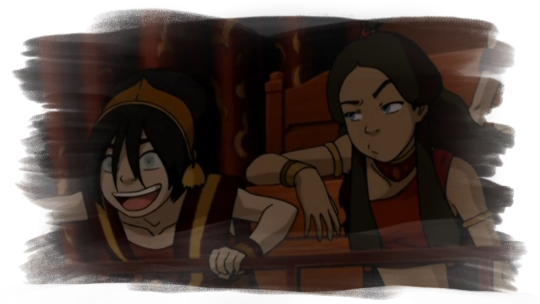
[ID: A shot from the same location as before, this time Toph has a huge smile on her face and is leaning on the balcony excitedly while Katara is leaning towards her, annoyed by her reaction. /End ID]
While it would have been better if Toph was actually listened to, it would have been…fine? if a justification was given for why they had to sit there (e.g. to avoid being recognised), if Katara had actually described the play for her. This wouldn't have been ideal, but it would have been better at least. In real life, many movies, TV shows (including this show's sequel series, The Legend of Korra) and other forms of visual media have an Audio Description track that does exactly that. If they weren't going to move for Toph to be able to see better, having Katara describe the play could have introduced kids to the fact this is an option. but instead it's brushed off, and I'll admit, it left a bit of a bad taste in my mouth, even back in 2006.
The Library is a bit more forgivable in my opinion, since Toph is still new to the group, but in this episode, she states that she doesn't want to go inside the spirit library because she isn't able to read and therefor there wouldn't be anything for her to do. However, it still would have been nice to see her friends consider this at all before they actually arrived. They could have (and should have) still gone, but some acknowledgement that they at least thought about the inclusion of their disabled friend would have been nice.

[ID: A shot of Aang, Katara, Sokka and another man are talking while looking down at a map on the table. Meanwhile, Toph is sitting on the other side of the table, completely disinterested as she sips from a large ice cup with her feet up on another chair. /End ID]
Alternatively, I do feel like Wan Shi Tong, a self-proclaimed all-knowing-spirit or his assistants would have been able to point her in the direction of something to interest her, since he does imply books aren't the only form of knowledge he collects.
The reason I mention this though is two-fold.
In real life, disabled people are very often left out of "fun" group activities, whether that be in formal settings or in casual ones, like hanging out with friends. If the episode had been framed as "the Gaang learns about the library and decides to track it down," I might have been less critical, but it's specifically framed as something that at least starts out as a kind of break for the team where they all take turns picking out fun things to do so they can rest, and Toph's access needs not being considered at all until they're already there hits a bit close to home, especially since they just end up leaving her outside. Secondly, there's also a stereotype that disabled people (and especially blind people) don't belong in academia and places of learning, such as in this case, libraries. This stereotype is about as old as the concept of organised institutions of learning, and definitely isn't unique to AtLA, but the assumption is often that disabled people wouldn't be interested in more formal methods of learning, so it's not worth accommodating us. With blind people in particular, when I've seen this in media, the premise is often "well I can't read anyway so why bother?" which Toph definitely falls into here with no push-back against the trope.
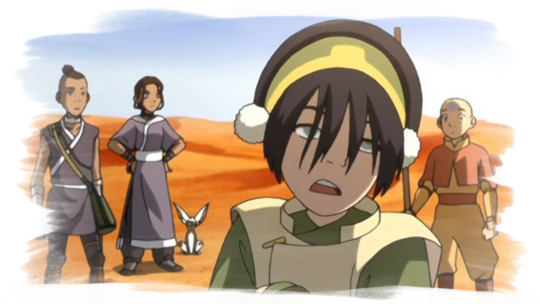
[ID: A close up of Toph and the rest of the group, Katara, Sokka and Aang standing in a desert. Toph shrugs, looking bored, while the others looks confused and surprised with the exception of Katara, who looks mildly annoyed, standing with her hands on her hips. /End ID]
It does make sense that she would have been resistant to going in, and I'm not saying this episode should have turned Toph into a bookwork akin to Wings of Fire's Starflight (another blind character) or anything. But there was a chance in this episode to push back against some of these assumptions, and I think it's a shame they missed it. How cool would it have been if Toph had mentioned not feeling welcomed in more formal learning spaces because of her disability, which was just reinforced by the way her old earthbending instructor and her parents treated her. She decides to go inside the library anyway as "backup" in case something goes wrong, grumbling about it the whole way down. Wan She Tong starts his introduction mostly the same way, saying humans aren't welcome and Toph makes a snarky comment about it. Wan She Tong, equally offended that this human thinks he, the all-knowing-spirit, wouldn't have considered something, shoots back with an annoyed comment about humans being so self-centred. He explains that spirits come in all shapes and sizes, and not all of them have eyes, but they can still access his library. She's not the first sightless being in his study, and he-who-knows-ten-thousand-things knows this too. Once everyone is permitted entry, one of the knowledge seekers shows her to a series of slates about a lost earthbending form that she can actually read (or at least, "see" the pictures on) because it's carved. Or instead of a slate, it's a series of statues outlining the form, similar to what Aang and Zuko find in the episode "The Firebending Masters". Perhaps this form is something that helps her develop metal bending later on, and lays the groundwork for Toph becoming interested in teaching in the comics.
And finally, Toph and Katara's segment of Tales of Ba Sing Se. Katara convinces Toph to go get a makeover with her as part of a girl's day. Overall, this segment of the episode is pretty nice, and I liked that they showed that a person's gender expression (in this case, being a tom-boy) doesn't mean they can't like things outside of what we usually associate with that. Tom-boys can like girly things on occasion, and vice-versa, and I think this is an example of an episode that would seem a bit ham-fisted today, but honestly, was needed in 2006. However, there's a throw away joke where Toph says "as long as they don't touch my feet," and it immediately cuts to show spa workers filing down the calluses on her feet in a way so painful several staff are required to hold her down.
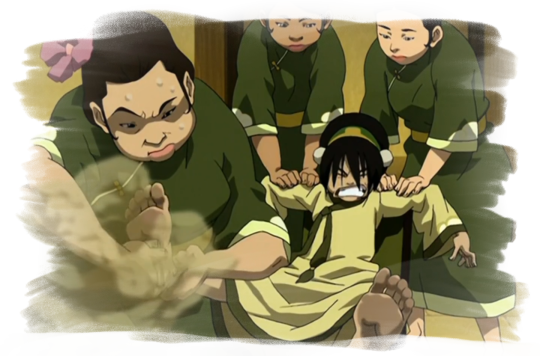
[ID: An image of Toph in a bath robe being held down in a chair by two spa workers while a third scrubs at her feet so hard that she is sweating. Meanwhile Toph is fighting against the two holding her down and has a facial expression like she is in a great deal of pain. /End ID]
this might be a minor thing in the grand scheme of the show, but it's still another example of Toph's boundaries about her disability and her access needs being disrespected by her friends, which the show just doesn't acknowledge it at all. People ignoring Toph's wishes about a part of her body she depends on in a much more direct way that others do is played off like a joke in a montage of otherwise enjoyable and goofy activities and this is a very, very common experience in disability circles.
There are a number of other, much more minor issues that show up with Toph as well, such as the fact she's the only one of the main cast who never has an on-screen (or on-page) relationship. not in the original show, not in any of the comics and not in The Legend of Korra. Again, it's not a big issue on it's own, especially because in AtLA, she's young enough where it's possible that she was just not interested yet, and she does have kids in The Legend of Korra where she mentions a relationship with a man named Kanto (Lin's father). So it is implied she does have some form of relationship eventually, but the issue is that it's never shown on screen or on the page. This feeds into a wider pattern in media of disabled characters being the only ones in their respective cast not given on-screen romantic relationships in stories, and so I still think it's worth pointing out, especially since the creators have had a lot of opportunities to correct that by now.
Toph is also portrayed, pretty much undeniably, as the best earthbener in a way that, at times, comes across almost like the creators felt like they need to compensate for her being on the team "despite" her being blind. This trope is one that I think Toph, at least partially, helped to popularise with the current generation of story tellers: The Disabled Savant. In this trope, disabled characters aren't really given the same room for growth as other characters; they aren't permitted to be average or still learning, they start good and get better. If they do progress, they often become the best, which is the case for Toph. To be fair, everyone in the The Gaang is the best at their respective skill by the end of the first series, which is why I say this is a minor point. She dose, however, have the least amount of on-screen growth in skill out of the whole team. Katara starts out barely able to lift any water at all, let alone actually bend it. Sokka is skilled with weapons from the start but does get his butt handed to him a number of times by others with more experience than him whom he learns from throughout his story arc. Zuko spends most of the early-to-middle of the show having things "blow up in his face" (to use his own words) and being belittled by his family of prodigies. While Aang is an airbending and, to a lesser extent, waterbending prodigy, he fails at pretty much everything else for a while before he starts to find his confidence - especially earth and firebending, not to mention the entire situation with locking himself out of the Avatar state. Toph is the only one who doesn't seem to fail or struggle all that much from a combat perspective. She does grow and improve in her bending (she invents metal bending after all) but she never has any moments where she really messes up or even struggles in combat all that much compared to the others.
All of these points and criticisms I've mentioned are not necessarily big in and of themselves, but when looked at together, they build up to create some issues with how Toph is depicted and how the people around her treat her disability
So that's it then? Toph is bad disability rep and Avatar should be "cancelled"?
God no. Like I said at the start, I still adore Toph and Avatar as a whole, but the show is a year away from being two decades old, it's bound to have some elements that don't hold up and I think it's worthwhile discussing them, specifically because I love the show and it's characters. Despite all the negativity I've brought up, I do think there are a lot of things AtLA did well with Toph too.
I've mentioned a few times that we rarely see how Toph's blindness impacts her life outside of her bending and combat abilities, and there's a reason I made that specification. Unsurprisingly, if you know much about the show's development, the ways in which Toph’s blindness and seismic sense impacts her bending and fighting style is one area where the show really does shine, and I still think that is worth a mention. The various types of bending are based on different styles of martial arts, specifically, different types of Kung Fu. Most earthbending in the show takes heavy inspiration specifically from Hung Ga, but Toph is different. Her bending heavily references Southern Praying Mantis Kung Fu, something unique to her within this world.
The reason for this (outside of simply wanting her to be visually distinct) was because the show’s creators made sure to consider what limitations Toph might have and what parts of the more common earthbending styles wouldn't work for her. Since her connection to the earth was critical in order for her seismic sense to work, they decided on a style that would keep her feet on the ground more, prioritised strong stances with minimal jumping and put more focus on attacking with her upper body. While not an intentional choice, the style they went with for Toph, according to the show's head martial arts consultant, Sifu Kisu, was supposedly developed by a blind woman in real life, at least according to legend. The creators also made further adjustments to the style with the help of martial arts consultants and just watching Toph fight is evident that a lot of love and care was put into the decisions made on that front.
I also appreciate that Toph's disability wasn't off-limits to joke about.
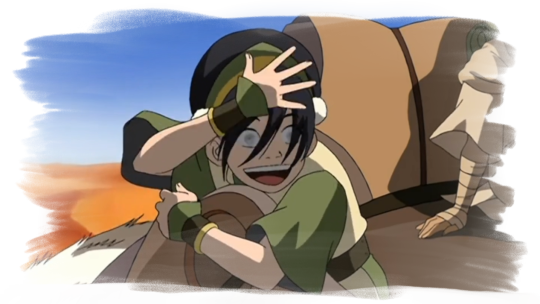
[ID: A picture of Toph waving her hand in front of her face with an exaggerated smile to remind the others she's blind. /End ID]
As I already mentioned, they didn't land 100% of the time, but lot of shows are afraid to use disability as a source of jokes, which would have felt weird and out of place in a show like Avatar. I see this hesitance in real-life too; people get extremely uncomfortable when I joke about my own disabilities and I've heard several people and even disabled comedians talk about the same observation. My last video on Tik Tok that got outside my usual audience was a joke about my prosthetic leg, and every single stictch and duet I received was people saying some variation of "I'm such a bad person for laughing!" "I'm going to hell!" or just straight up asking if they're aloud to laugh. If I didn't want you to laugh, I wouldn't have posted the joke! But joking about disability does make it more approachable.
Despite how often Toph and the others made blind jokes though, outside of the one instance I mentioned earlier, they never felt mean-spirited or like they were punching down. Even when a very sleep-deprived Katara was intentionally trying to be.
I think it's also worth keeping in mind the context of the media landscape when Avatar The Last Airbender was airing. Today, characters like Toph are very common, so much so there's a whole trope about them (super-crips) but at the time, having a character with a major disability be a main character in an action-orientated kids show like Avatar was really rare. She wasn't the first of course, but a lot of the time, if they were included, they were almost certainly sad and depressed, wishing for a cure or they were designated to the roles of "Guy in the chair" (which is a character, usually a tech person, who helps from the background), inspiration, scary villain fake-out (or other variations of "creepy" character) or the actual villain. Having a character that was not only comfortable in her skin as a disabled person, who didn't want or need to be "fixed" or "cured" to be directly involved in the story, and who's main obstacle (at least in season 2) were how the people around her treated her, was pretty ground-breaking at the time (pun not intended) and went against the most prevalent stereotypes of it's day.
And I really want to emphasise that. For many Millennials and older Gen Zers, myself included, Toph was the first character that didn't tell us we were broken and needed to be fixed in order to be part of the group (even if they slipped up with that messaging occasionally). Prior to seeing Avatar, I honestly thought there was something deeply wrong with me for being happy with my life (a reminder, I was 10 years old when this show first started airing), because every other disabled person in the media only ever talked about how much worse their life was because of their disability, how much they hated it and how much they hated themselves. Many outright said that they wished they had died rather than become like me. Toph wasn't the first to go against those tropes, but she was the first example of a disabled character who wasn't like that many people my age saw. Did she do it perfectly? Hell no, but personally, back then, I was happy to have a character who maybe over-corrected and took things a bit too far than another sad character talking about how lives like mine weren't worth living.
I also deeply appreciated that Toph did struggle with her independence, at least initially, and where to draw the line with accepting help. Because of how much she'd been coddled and overprotected as a little kid, she saw any attempt at people being helpful and working as a team as them trying to baby her. It was very on the nose, but I liked that the show gave her an episode just dedicated to realising that it's ok to accept help. Again, this is a bit of a story telling trope today, but having the disabled character realise that it's ok to accept help, and to do it without talking down to them or saying that them wanting independence was bad, was a refreshing change compared to what was around at the time.

[ID: a zoomed out image of Toph, standing before her parents with Aang, Katara and Sokka standing behind her. /End ID]
While I think the show's creators could have benefited from consulting with disabled people and specifically blind people the same way they brought in consultants for the martial arts featured in the show, it's very clear to me that the intention behind Toph's character was good, and that actual effort was put in to make sure they depicted her well, even if some of it was a bit misplaced. It's also worth noting that the groundwork for a lot of my suggestions is already in place, they just didn't follow it all the way through.
Overall, I'd say Toph was good for her time, and she's what was needed in the 2000's, even if she doesn't hold up as well today. I also think it speaks to how far we've come in terms of disability representation. When I first started engaging with the online fandom directly, almost no one, even other disabled people, argued that Toph wasn't good representation, because honestly, the bar was on the floor and we were just happy to have something different. But now there are options, and the standards are higher, and that's so, so good. It means that people, even in the media, are starting to listen and be more thoughtful about their depictions of disability than we were in 2006.
And finally, I want to really quickly mention The Netflix adaptation of Avatar. A few people have asked me now what I think they should do with Toph when they get to her, and what my predictions about the show are. I'm not going to talk about my predictions here, because this post is already way too long and that's not what this is about, but I don't think the suggestions I made today would necessarily work in this particular remake, primarily because of the tonal differences. Some adjustments definitely could, such the other characters doing a better job at listening to Toph when she points out inaccessibility and them actually considering her in the first place, but others might be harder to balance. The original show could get quite dark and serious at times, but it was primarily a light-hearted adventure story for kids. From what I've seen of the live action remake though, they're more heavily leaning into those serious elements - for better or for worse, and as such, trying to tone Toph down in the specific ways I mentioned might not balance out as well as it would in the original show. At the very least, the specifics would need to be different. To be honest, I'm not entirely sure what approach they should take, that's not really the point of this post, but I did want to quickly address it to avoid confusion. My suggestions today were specifically on how to approach the cartoon version of Toph for a modern audience, and were not meant to be read as suggestions on how her live-action counterpart should be depicted.
#writing disability with cy cyborg#Wow I had a lot more to say about this than I thought (I think this is my longest post to date lol)#writing disability#disability representation#writeblr#writing#Avatar#avatar the last airbender#atla#Long Post#toph#toph beifong#the gaang#Animated Avatar#disability in media#fantasy
225 notes
·
View notes
Text
Simon not knowing where the Bus was going and Betty turning into Golbetty right before it leaves is less to say her fate is ambiguous and unknown to even her but more so Simon and her can truly no longer travel together, more so he can’t come with her.
And that he finally realized that.
#he’s stops himself from going despite Betty projecting the happiness it would’ve brought her#cause it’s not how they were and it’s not what he did#as the entire series he was trying to switch the roles#Betty is the chaos embodied natural world now#her fate is that of the aggressive unknown itself#it’s not a great date but it’s pretty cut and dry that’s what she is and forever will be now#and I thinks it’s good cause she gets to make all her choices for herself without feeling swayed to sacrificial cause she is the sway now#simon petrikov#Betty grof#adventure time#fionna and cake#fionna and cake spoilers#petrigrof#last post I need to sleep
412 notes
·
View notes
Text
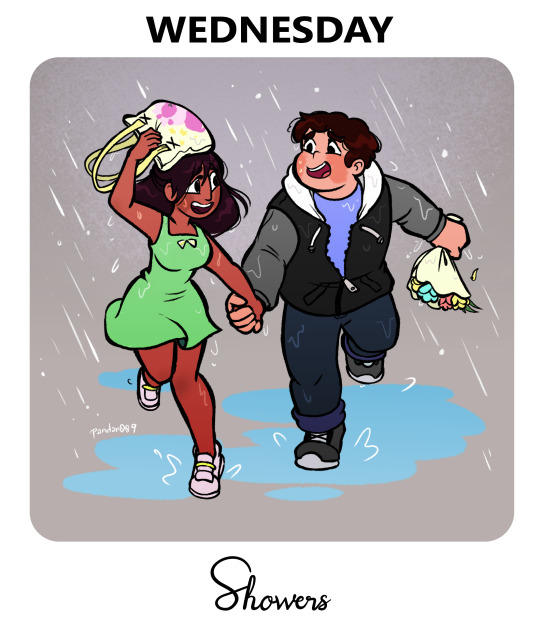
Wednesday: Showers
So much for a sunny date. ¯\_( •́ ͜ʖ •̀ )_/¯
Personal connverse week for an anonymous Ko-fi tipper!
Prompts, details, and polaroid border effect also by anon.
#connverse#Connie Maheswaran#Steven Quartz Universe#SU#my shiz#Ko-fi#Ko-fi request#It's a rainy date now!#Connie brought him flowers and Steven drew Lion on her bag. I don't know how important that info is though..#You know they intentionally ran on those puddles.#I'm scheduling these and I don't know if it actually got the time right. Last time I did it posted two hours in advance.
548 notes
·
View notes
Text

school starts again in a few days 🫠🫠
#nutbread's art#obey me#anyways tysm for my last om post :'D#that fanart single handedly made me gain over a hundred followers#i was vry flattered with all of u guys' rbs and comments ty again :“d!!#obey me mammon#obey me shall we date#obey me nightbringer#obey me fanart#obey me nb#obey me swd
551 notes
·
View notes
Text
Demon: Barbatos? Barbatos is that you!? & MC!?
MC: Stabby Sammy!!! Hey!!!
Barbatos: Oh good afternoon Stabby Sammy, a pleasure seeing you out & about.
Stabby Sammy: About time right!? Oh well I gotta run, have a good day both of you!
Barbatos: You as well.
Simeon: Stabby Sammy?
Barbatos: We met in jail
Luke: Jail!?
#Kinda related to the last post lol#obey me#obey me barbatos#obey me incorrect quotes#obey me headcanons#obey me imagines#obey me scenarios#obey me crack#obey me shitpost#obey me humor#obey me shall we date#obey me mc#om! mc enzo content#◇˖・゚— › cosmic obey me . ⊹#happy birthday barbatos 2023#obey me simeon#obey me luke
501 notes
·
View notes
Text

Reverse Bunny: Solomon
#THAT’S IT FOLKS#Solomon is the last bunny and my hands are dead but IT’S TIME#ITS TIME FOR VALENTINES DIALUCI BUNNIES#I’ve been looking forward to drawing them for two weeks ❤️ 🖤#obey me shall we date#obey me nightbringer#obey me solomon#obey me reverse bunny#reverse bunny#my smut art#obey me#fanart#obey me fanart#i was originally making these as shit posts but i ended up taking it seriously lol#a bunny per day until valentines#obey me nsft#obey me smut
221 notes
·
View notes
Text
Lucifer telling the others about Lilith for the first time!
[ Spoilers for Belphie's UR card: Avatar of Sloth ]



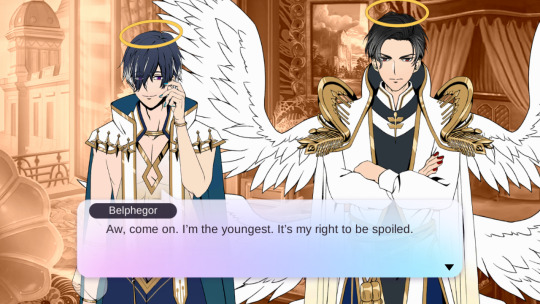

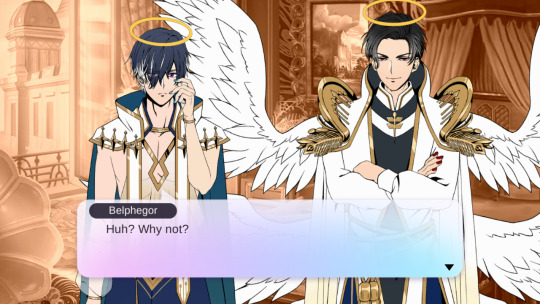

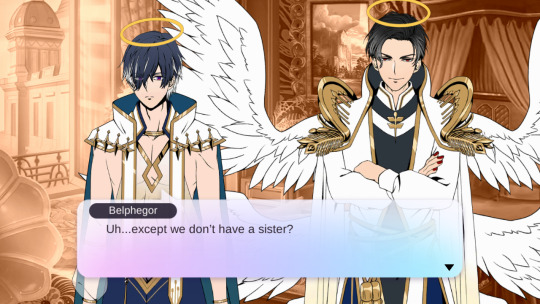
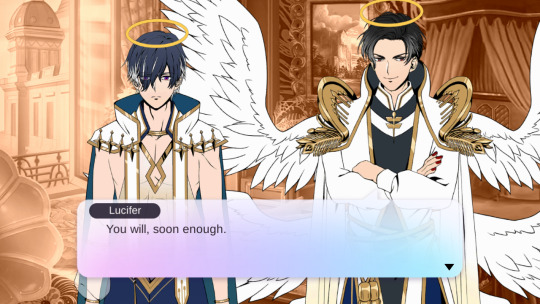


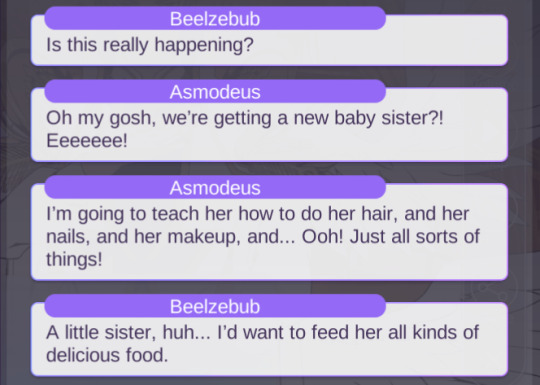

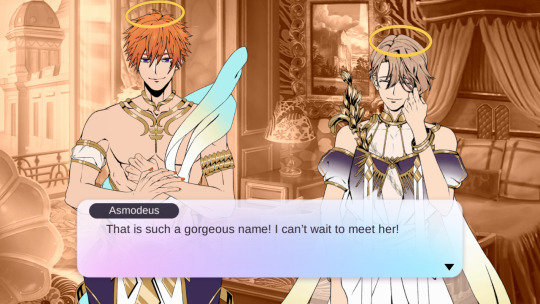


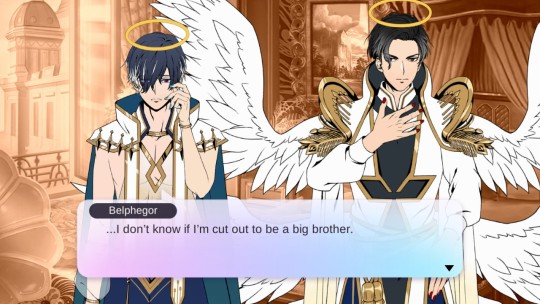

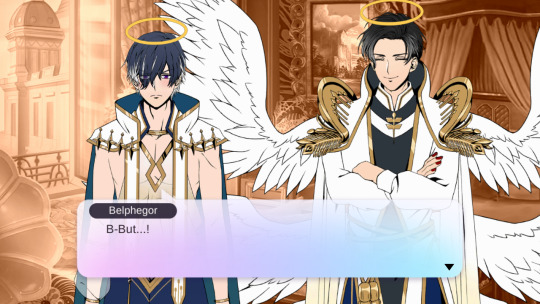
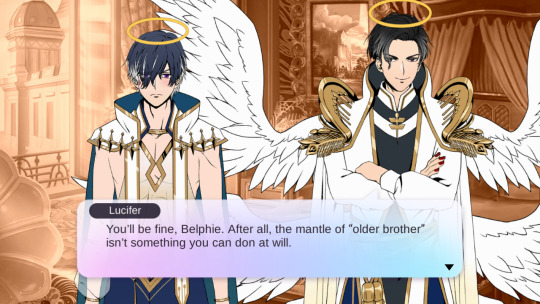







#I'm sorry but the idea that Lucifer was just adopting ppl left and right during his celestial realm days is so funny to me#and this instance in specific was so jsjwjqks#man really just came home to his kids one day and went: “We have another one on the way😊”#and the fact that everyone immediately accepted and didn't even question it like it's a normal tuesday djsjsjsjs#he just can't beat the single dad allegations and I love him for that#absolutely adorable I loved getting through this card#this was a second part to my last post?#omnb card: “the avatar of sloth” ( belphegor )#obey me#obey me nightbringer#omnb#obey me shall we date#omswd#obey me devilgram#obey me lucifer#obey me belphegor#obey me beelzebub#obey me lilith#obey me asmodeus#obey me screenshots#☙ no creativity for names ✾
408 notes
·
View notes
Text
My Incredibly Spoiler Heavy Thoughts on Nightbringer
TURN BACK IF YOU HAVE ANY INTEREST IN PLAYING THE GAME AT ALL. I MEAN IT.
Hello. I have completed all 10 lessons on the Normal difficulty. These are my thoughts:
First, a disclaimer. All of this is my opinion. If you feel differently about a character or plot point, that's fine. This is all just as I see it.
Holy hell, I love the setup here so damn much. The Nightbringer story so far is truly more than just a rehash of the OG plot, largely because of all the small stuff that keeps happening in background. Yes, we're befriending the brothers again, but we don't know WHY. Why are we in the past? Who sent us there? What do they want from us, or... what do they want out of somebody else?? 👀 I have to hand it to the writers for coming up with this premise, it's soild. Will they stick the landing...? We'll see.
The New! (Old) Cast
Lucifer:
Whelp, Luci is being colder to us than ever... But far more openly involved with his brothers than we saw previously. You can really tell that this is fresh off of the War and he's just trying his best to keep everybody corralled and (somewhat) comfortable.
He still holds onto his Celestial Realm prejudice against demons, so he doesn't trust MC at all which is an interesting turn on the dynamic from before. As a human, Lucifer saw us as weak and insignificant so he didn't give us much time of day. But as a "demon," and someone more knowledgeable about the Devildom than himself, he has to suck it up and rely on MC even if he wants them to stay away.
By the end of Lesson 10, it's safe to say whatever trust he had in MC is going to be shattered. MC has talked their way out of a lot, but even Dia looks shaken by their abilities this time... I'm curious to see if they can reestablish a relationship with him when he was already keeping them at arms length to start with.
Mammon:
Ah, Mammon... Once simp, forever a simp across time and space. Bless him. I guess he's just doomed to always fall first when it comes to MC. It DOES NOT take long for him to be down bad even if you don't romance him specifically (I would know because I'm trying to stay mono-Levi this go around).
Aside from his tsundere-ness, though, we do get a look into more of his insecurities. I find an interesting pattern developing in him where he just tends to latch onto a person and follow them unfailing. He did that with Lucifer before the Fall, he didn't even think about the consequences before going through with it. You could see him doing much the same with MC. I think it stems from a lack of confidence in himself and his own abilities, constantly relying on others to guide him through big decisions and provide him with validation. Add another poor thing to the list...
Leviathan:
I swear to God, the devs realized that Levi's charm lies in his pathos, so they went out of the way to make him EVEN MORE pathetic than normal. I still love him for it, of course. But seriously, Levi starts out practically afraid of his own shadow when the story starts. It makes sense, Levi would have probably one of the more negative impressions of demons of the seven, having fought them head on. He was a shut in before the War and now he's even more terrified to leave the house, let alone his room... (I can't be the only one who's wondering how the hell Dia's going to look at him and go, "Ah yes! I see Admiral material right there!" right?)
I do like that the writers took the time to show that he's one of the more empathetic brothers, right alongside Asmo and Beel, even if he's bad with people. Levi is quick to sympathize with beings and creatures who don't fit in and it's always very sweet to see. I also guess that Simeon wrote TSL in secret or after the War? You think he would know of it at least having lived so long with the author... Anyway. I digress.
There's a lot of... small things around Levi that I think hint at the inner feelings of the brothers, though (of all seven of them, he has the WORST poker face I swear). I may touch on those in another post because I need time to gather my thoughts on how it all connects there... Anyway, he's still my favorite and I'm going to try to see if there's any truth to this "you get a deeper connection if you stick to one brother" thing. Wish me luck.
Satan:
Okay, load your guns now because I think Satan is the real star of the show here. They're actually pulling way more than the "He's mad because he's seen like Lucifer" card. We're at a point where Satan doesn't even consider himself associated with the brothers AT ALL. That means something and has consequences on the story. He didn't even go with them to check on Beel, despite having enough fire power that he could have probably helped a lot.
Now before someone goes screaming at me that they've devolved him into comic relief, I'd first like to ask what did you think he was going to be? OG Satan told us himself that he used to feel nothing but anger. He's going to be pissed, irrational, and violent. He's Wrath.
What truly they're giving us under all of that is a look into a vulnerable guy who doesn't know anything about the world around him and is trying to pick it up on his own because his brothers can't (and maybe won't) teach him. They keep chaining him up (which I hate btw) and talk about him like he's a beast. But it's partially because they're such terrible communicators that he flies off the handle so often to begin with.
Satan is more alone than really anybody else is the Devildom. His brothers already have all this history together and memories shared during their time as angels, stuff he has no context for and could never experience himself. He's still an outcast among demons for his association with them, despite being a fully fledged demon in his own right, and he doesn't know why he has to be linked to them because he barely knows them anyway. He's taking baby steps to understand the world, but when he goes to his brothers to ask questions they lampshade him for even having clear thoughts. All they see him as is a roaring beast. This version of Satan is fascinating to me. How does he start here and end up the eloquent, emotionally-controlled bookworm with a planet's worth of connections? I gotta know!!
Asmodeus:
They FINALLY started giving Asmo his proper flowers! I still think it could have been more, but he's gotten way more depth than he had before. I know that Asmo part technically involved MC's input the least out of all of the brothers, but I think that was by design.
Asmo is a surprisingly introspective individual under his urge to perform. MC didn't have to give much input because he just didn't need as much. He knows himself very well (unlike some of the others). He's an emotionally intelligent guy who can sort out his own inner problems and remain empathetic enough to want to help his brothers in his own way. I wanted to hear more from this side of Asmo, honestly, but the game seems to make it clear that he's content with his spot of being the family's brightest smile. I hope it makes more appearances as we go on.
Beelzebub:
This one is tricky, because lesson 10 leaves off on a cliffhanger related to Beel... So I think Beel's feelings will have more consequences than the other brothers' on the story. Most of all that we see of Beel is, unfortunately, him being hungry or off being wholesome with Belphie but lesson 10 did give us some eye-openers regardless.
First, apparently if he flies off the handle, Beel is quite the challenge to handle. It takes Dia himself to restrain him, which is pretty insane for the sixthborn in the line-up. It's possible some outside magic is cranking up his power somehow, but we won't know until the next lessons are out.
Secondly, I find it very interesting that Beel's "heart-to-heart" moment with us is being saved for last... It was definitely the most surprising one of the secrets in the teasers (in my opinion). Beel and Belphie are glued to the hip and share everything together so for him to have a secret "not even Belphie" knows is pretty shocking. I hope it's not just that he saved Belphie instead of Lilith since we all already know that. It'd be a pretty cheap pay off to all this buildup... Not that I haven't been disappointed before or anything.
Belphegor:
Similar to Beel, Belphie doesn't get much attention until the end and it isn't much that we haven't heard before, unfortunately. You kind can't blame them, since plumbing out Belphie's inner trauma about the War was the entire climax of the first game. It's nothing we don't already know. That being said, I think there's some more interesting things that are being said about Belphie or left unsaid by the others that I find more fascinating to keep track of.
TLDR, I think there's some weird distancing going on between Belphie and the others. It doesn't seem super apparent, but Levi dropped some weird bombshells early on and I can't help but notice how he just never seems to be without Beel. Those two are close, yeah, but in this game they're practically a unit. I'm pretty sure Belphie is using Beel as a security blanket of sorts. He's also the ONLY one to mention Lilith in any great detail. Unsurprising, but it's worth noting that the others haven't really brought her up despite it (supposedly) starting the War.
Diavolo:
Somebody give this guy a vacation and a raise... So apparently, the brothers were cast down, the old King took one look at them and counted to seven, then conked out. Now our boy has to rule the kingdom. He's... the same really. As far as I can tell. You can really see how much he's taken to the brothers' antics though, which checks out in the other game too.
WAAAY more fascinating to me is apparently there's some kind of body called the House of Lords who think that Dia is too young for the job. What's the House of Lords?? Who are they? Are they like a council or advisory board...? Or is this a UK setup? Is there a Parliamentary board?? I dunno, could just be my Poli Sci talking but I'm now so lost on how the Devildom operates now...
Barbatos:
Oh my God, if there is any character I could live vicariously through, it was Barbs here. For whatever unnamed reason he is NOT having any of Solomon's shit right now and I'm living for it. Setting my delight aside, we don't get to see very much of him and what we do see doesn't really differ from the norm, which only makes his detest all the more shocking.
Through Barbs, we also see just how potent the power of the pacts can be when Solomon summons him and more or less forces him to do as he says. Nothing seems to stop him from retaliating after the fact, as he sent Solomon off who knows where, but seeing that kind of power wielded over a being who's almost unattainable to us is... Well. I feel bad for Asmo.
Simeon:
There's a lot to unpack with Simeon... and a lot of it is in the stuff that goes unsaid. First, I already found it strange that he didn't seem surprised to see Satan in the House. Or if he was, he didn't say it or bother introducing himself which is... telling for a guy like Simeon. He's back to being Luke's minder in front of demons, but I can't help but notice that he doesn't do much to counter Luke's tirades. He only indicates that it's impolite to say them, so he may still harbor the very same feelings.
Simeon and Lucifer have something of a heart to heart together that they never would in the OG title where Simeon admits his biggest regret. It isn't that he didn't follow Lucifer, as we might think, but that he doesn't feel like did enough to reach out to him before he made his decision. Lucifer dispells this, but I think it goes to show that Simeon stands behind his decision to stay and that it was the better option. Lucifer also confront Simeon on why he didn't take a high position (seraph) and instead settled for archangel. It's left open ended what his real motives for that would be, but I suspect that it has something to do with Simeon's troubling streak of going against the grain, even in subtle ways. Or he has too much anger about what happened to accept taking Lucifer's old position.
I found it interesting how easily these two seemed to talk about intimate topics together here where Lucifer barely even acknowledges Simeon's attempts to reach out in the OG story. I wonder what may have happened to sour their relationship so severely...?
Luke:
Luke the Racist Chihuahua returns!! Okay, I'm being a little mean but he's pretty much just self-righteous little kid the whole way through. I will admit, it is a little funny that the person who came up with the nickname was actually Lucifer. I think it's now retconned and confirmed that Luke and the brothers never knew each other before the Fall... though Luke seems to know OF their former selves in some capacity. I could be misinterpreting things though.
The Rat Bastard Solomon:
I swear to God this was me playing through the whole game tied to this guy.

He's lying. A lot. Constantly. And it pisses me off to no end. I was wondering why things he was saying and the stuff he was doing weren't lining up and OF COURSE it's because he's either working his own agenda or being outright deceitful. I hate him so much, y'all, you don't even know...
That aside, as an impartial observer Solomon is pulling a lot of work to support MC and you can TELL how down bad he is for them, which actually has significance for the plot I think. He's keeping them in the dark about something, but considering his feelings I say we can at least be charitable and assume it isn't to hurt them or cause them any suffering... intentionally. He's also as unscrupulous as ever, considering how he ordered a very angry Barbs around and more or less took advantage of a life or death situation to make a pact with Asmo.
So. At the end of the lessons, we're reintroduced to the mysterious Nightbringer. The character who actually sent us back in time at the start of the game. Yeah, it wasn't Barbatos... probably. At least not our reliable neighborhood butler anyway. They seem to be different entities but I THINK they might share some connection....
I have to wonder who disguised MC when they first arrived. The marketing made it seem like it would be Solomon but the marketing has been hit or miss on actual accuracy about the game we're seeing. If it was Solomon, then he had to have known where the MC was before he called. If it was Nightbringer then... well actually. We need to touch on that first.
Nightbringer:
Now, much of this is just me speculating so take things with a grain of salt. Nightbringer's name is blocked out, but it seems like it identified itself to us in the beginning before sending us to the past. It appears like it wants something from Solomon.... to fully corrupt him maybe? And it's using MC as leverage against him.
I suspect that all of the weird stuff that has been happening is tied to its meddling in some way, but to what end is unclear... Sending Levi and MC into TSL, tricking Asmo then trying to feed everyone to a spider, and, likely, whatever is going on with Beel. I can't tell if it's trying to push MC and the brother's closer together, or just making vaguely comical attempts at homicide by fictional characters, spider, and Gluttony incarnate.
The situation with Adam does give us a hint into its nature. It appears to be some kind of dark, trickster being that gives a person what they desire, but never the way they intended. A walking monkey's paw, if you will. Solomon says that Nightbringer made him what he is today, so perhaps he worked under it or is simply under the influence of one its "deals." Their relationship is adversarial, though. When they're speaking, they talk about the two supernatural sides, Angel and Demon, and Nightbringer seems to want to force Solomon to make a choice between them. Lose his humanity, maybe?
I'm not quite willing to say that Nightbringer is a demon just yet, at least not one of the ones we normally encounter. Something about it seems... older. More powerful than that. But we'll have to wait for more info.
My crackpot theory?
Solomon has made a deal with Nightbringer in order to go back in time and do... something. He's after something. Nightbringer agreed, but dragged MC along as collateral for Solomon to get it done within a certain amount of time or makes sure he honors his part of the bargin. Barbatos knows this, either because he is linked to in some way to Nightbringer or saw it happen in the doorway, and is disgusted by his actions but unable to speak about it due to the pact. Or, you know. That's our present Barbie also dragged along for the ride and he's pissed that he's been essentially hijacked and taken away from present Diavolo, but forbidden to speak about it.
#i may do ONE LAST analysis post#over my speculation#and just weird stuff I saw#but after that#it’s back to the normal content#obey me#obey me shall we date#shall-we-date-obey-me#obey me nightbringer#obey me analysis#obey me nightbringer analysis#om spoilers#omn spoilers#obey me spoliers#obey me nb spoilers#obey me nighbringer spoilers
773 notes
·
View notes